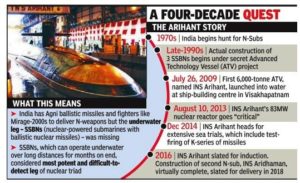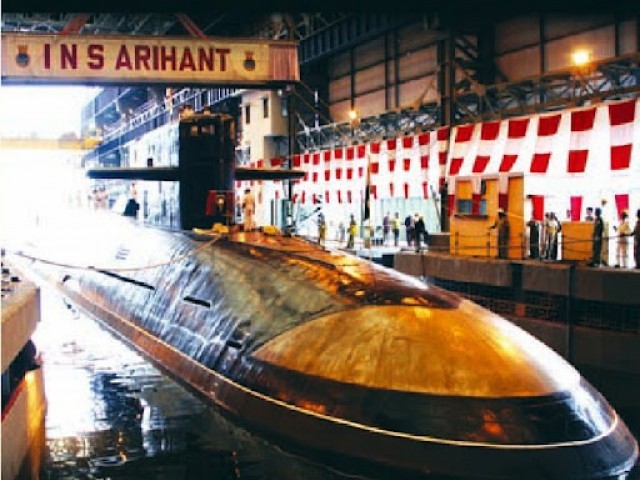India is finally close to operationalising its long-awaited nuclear weapons triad — the capability to launch nukes from land, air and sea.
About Nuclear Triads :
A nuclear triad refers to the nuclear weapons delivery of a strategic nuclear arsenal which consists of three components: strategic bombers, intercontinental ballistic missiles (ICBMs), and submarine-launched ballistic missiles (SLBMs).
- The purpose of having a three-branched nuclear capability is to significantly reduce the possibility that an enemy could destroy all of a nation’s nuclear forces in a first-strike attack; this, in turn, ensures a credible threat of a second strike, and thus increases a nation’s nuclear deterrence.
- India has recently become a nuclear triad with INS Arihant, which has been officially commissioned as of August 2016. INS Arihant will either carry 12 K-15 missiles with a range of 750 km or 4 K-4 missiles with an extended range of 3500 km.
- India maintains ano first use nuclear policy and has been developing a nuclear triad capability as a part of its credible minimum deterrence
- India’s nuclear-weapons program possesses surface-to-surface missiles such as the Agni II and Agni III. In addition, the 5,000–8000 km range Agni-V ICBM was also successfully tested for third time on 31 January 2015 and is expected to enter service by 2016.

- India has nuclear-capable fighter aircraft such as the Dassault Mirage 2000H,Dassault Rafale, Sukhoi Su-30 MKI, MIG-29 and SEPECAT Jaguar. Land and air strike capabilities are already in place under the control of Strategic Forces Command which is a part of Nuclear Command Authority.
- Tactical nuclear weapons are used in air, land and sea warfare. Air-to-air missiles and rockets, surface-to-air missiles, and small air-to-ground rockets, bombs, and precision munitions have been developed and deployed with nuclear
- Ground forces have included tactical nuclear artillery shells, surface-to-surface rockets, land mines, medium and small man-packable nuclear engineering demolition charges, even man-carried or vehicle-mounted recoilless rifles. Naval forces have carried nuclear-armed naval rocket-assisted and standard depth charges and torpedoes, and naval gunnery
- Tactical nuclear weapons and the doctrine for their use is primarily for use in a non-strategic war fighting role destroying military forces in the battle area; they are not counted toward triad status despite the possibility of many of these systems being usable as strategic weapons depending on the target.
India’s N – Triads,
INS Arihant’s 750km and 3,500km missiles may be somewhat dwarfed by SLBMs with ranges of well over 5,000km with the US, Russia and China, but the completion of the nuclear-triad is critical for a country like India, which has a clearly declared policy of “no first-use” of nuclear weapons. It makes its second-strike capability much more credible.
- A pre-emptive enemy strike can conceivably take out a rival’s nuclear missiles and fighter bombers. That is why an SSBN, capable of lurking underwater for months without being detected, is considered the most effective and deadly platform for a retaliatory nuclear strike.
- INS Arihant has undergone a whole host of surface and “dived” sorties during its trials to prove its sea-worthiness. But the full weapons integration with the “K” (named after former president APJ Abdul Kalam) series of SLBMs will take some more time. While the K-15SLBM has a 750-km range, the K-4 can go up to 3,500-km.
- INS Arihant is the first of three such SSBNs being constructed under the secretive ATV programme launched decades ago. The construction of the second one, INS Aridhaman, is also almost complete now, with its delivery slated for 2018.




